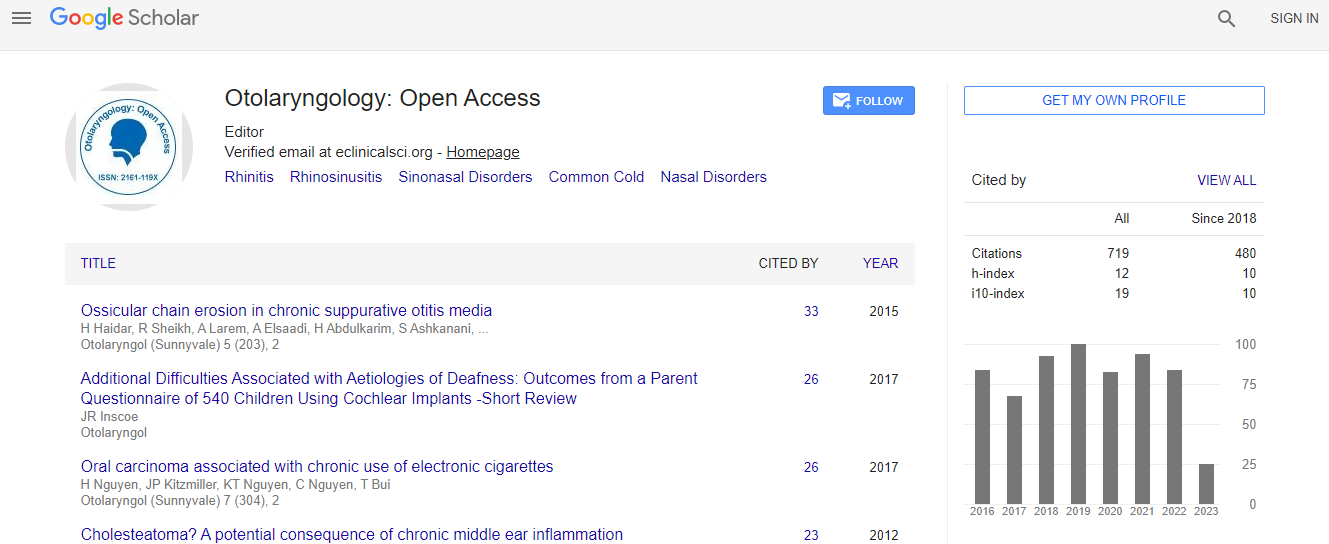Our Group organises 3000+ Global Conferenceseries Events every year across USA, Europe & Asia with support from 1000 more scientific Societies and Publishes 700+ Open Access Journals which contains over 50000 eminent personalities, reputed scientists as editorial board members.
Open Access Journals gaining more Readers and Citations
700 Journals and 15,000,000 Readers Each Journal is getting 25,000+ Readers
Google Scholar citation report
Citations : 925
Otolaryngology: Open Access received 925 citations as per Google Scholar report
Otolaryngology: Open Access peer review process verified at publons
Indexed In
- Index Copernicus
- Google Scholar
- Sherpa Romeo
- Open J Gate
- Genamics JournalSeek
- RefSeek
- Hamdard University
- EBSCO A-Z
- OCLC- WorldCat
- Publons
- Geneva Foundation for Medical Education and Research
- ICMJE
Useful Links
Recommended Journals
Related Subjects
Share This Page
Application of skin stretching technique for closure of large surface skin defects in children
5th Global Summit and Expo on Head, Neck and Plastic Surgery
Mariya Shcherbakova, Trusov A, Rybchenok V, Fomina M, Starostin O, Tsapkin A and Lagutina A
Speransky Children's Hospital, Russia
ScientificTracks Abstracts: Otolaryngol (Sunnyvale)
Abstract
Introduction & Aim: Large surface skin defect closure after extensive burn trauma remains an important issue in plastic and regenerative surgery. Deficit of intact skin dictates a careful and creative approach to donor skin surfaces. Skin stretching technique using endo expansion device is a promising approach to treat large skin defects. It allows a significant reduction of scar surface area. Application of this technique for free dermal transplants allows receiving skin grafts similar to normal skin. The goal of this approach is to form a full-thickness skin flap of a desired size in cases where traditional skin donor surface areas are limited or not available. The resulting skin flap could be used on various body parts. The purpose of the study is to further characterize and advance the method of skin surface expansion for auto-grafting. Materials & Methods: 25 patients aged 4 to 17 years with large-surface skin defects were treated using skin stretching technique. 24 patients had burn trauma and one patient had a trauma related to a car accident. All patients had scar deformations and various degrees of contractures, which were associated with significant limitations in their everyday life. Either large (120√?¬?45 mm) or small (90√?¬?45 mm) skin stretching devices were placed endoscopically. Radio knife √ʬ?¬?Surgitron√ʬ?¬? and hydro knife √ʬ?¬?Versa jet√ʬ?¬? were used for incisions. Skin stretching was achieved by gradual expansion of latex ballooning devices using 0.9% normal saline over a period of 4-8 weeks. Various body areas were used as a donor site for skin stretching based on individual cases - back, lateral chest and abdomen. Four patients received local intra dermal injections of botulinum toxin at the site of implantation of skin expansion device 3-4 days prior to the procedure. Results: Using skin stretching devices, we were able to get full-thickness donor skin surfaces ranging from 60 square centimeters to 300 square centimeters. Wounds were closed using adjacent skin tissue. Small linear normotrophic scars were formed as a result. Four patients had some degree of peripheral necrosis at the edges, which were successfully treated using conservative methods. Scar deformations and contractures were corrected in all patients. Recipients of botulinum toxin-treated skin grafts seem to do better during recovery period likely due to improved skin elasticity. Conclusions: Skin stretching technique has been proven to be a useful method in managing large surface skin defects in pediatric patients with various burn trauma, scar contractures, other traumatic causes of skin defects. Skin stretching technique allows receiving a full-thickness auto skin graft of a desired size similar to normal skin. This method solves a problem with lack of skin auto-graft for closure of large surface wound areas. Intradermal injections of botulinum toxin seem to increase elasticity of the expanded skin graft.Biography
Mariya Shcherbakova was graduated from I.M. Sechenov First Moscow State Medical University in 2013. She has completed her Pediatric Surgery Residency in 2016 and joined staff of Speranskiy Children’s Hospital in Moscow, Russia in 2016 as a Pediatric Surgeon and as a Staff Scientist. Her special interests include plastic and reconstructive surgery in children, treatment of children with post-traumatic and burn injuries, etc.
Email: childsurg.maria@yandex.ru

 Spanish
Spanish  Chinese
Chinese  Russian
Russian  German
German  French
French  Japanese
Japanese  Portuguese
Portuguese  Hindi
Hindi 
